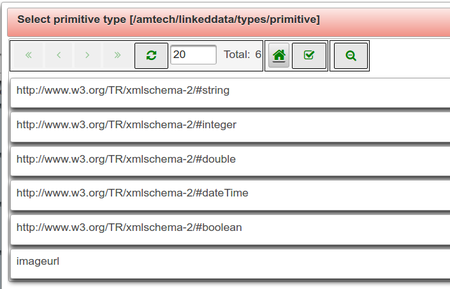Difference between revisions of "IoT Semantics"
(→Resources status) |
(→Publishing semantic) |
||
| Line 39: | Line 39: | ||
*the type can be deleted only if it is not used by anyone | *the type can be deleted only if it is not used by anyone | ||
*values for the validation of the supported properties that are published cannot be changed : min value, max value, min date, max date and validation regex | *values for the validation of the supported properties that are published cannot be changed : min value, max value, min date, max date and validation regex | ||
| − | [[File:Typepublished.png|thumbnail| | + | [[File:Typepublished.png|thumbnail|center|public]] *public types show this icon in the [[Tree editor|Tree editor]] |
| + | |||
== Resources status == | == Resources status == | ||
When a thing instance does not meet the requirements imposed by the semantic of the type the status of the resource is invalid. | When a thing instance does not meet the requirements imposed by the semantic of the type the status of the resource is invalid. | ||
;resource with invalid status do not returned as result of observers execution therefore are not taken into account by reasoners execution | ;resource with invalid status do not returned as result of observers execution therefore are not taken into account by reasoners execution | ||
Revision as of 14:02, 28 April 2016
Contents
Linked data
Resource Description Framework (RDF)
Json-ld
Json for linked data http://json-ld.org/
Entity and Observations semantic
Semantic for entities and the observations the produce can be defined using the Entity Types and Observation Types This configurable semantic in composed of :
- Type general info (name, description, geometric representation)
- Type specific properties
- In the case of the entity types, the set of observation types that the given entity type can produce
Each specific property contains its own semantic to define :
- Property data type; there are 3 kinds of property types
- primitive types
- collection things type
- collection/single things instances
- Valid range or regular expression according to the data type
- Translation to the supported languages
- Limit of copies to keep for the property
Entity and Observations instances
Instances are resources of a specific semantic type, that have values for each property defined in the semantic.
Publishing semantic
Semantic for thing and observation types can be defined without letting others see the changes. The action of publishing a type is what makes it visible to other creators, thus available for use by others in their activities. Once published, a type can only be extended by its creator.
When a type is published:
- it becomes visible to other creators that will be able to use it in their activities
- its supported properties become visible to other creators
- supported properties can only be added as long as their are not required
- existing supported properties cannot be deleted.
- the type can be deleted only if it is not used by anyone
- values for the validation of the supported properties that are published cannot be changed : min value, max value, min date, max date and validation regex
Resources status
When a thing instance does not meet the requirements imposed by the semantic of the type the status of the resource is invalid.
- resource with invalid status do not returned as result of observers execution therefore are not taken into account by reasoners execution


